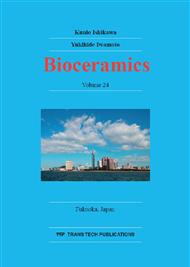[1]
S. V. Dorozhkin, Calcium orthophosphates, J. Mater. Sci. 42 (2007) 1061-1095.
Google Scholar
[2]
N. B. Roberts, H. P. J. Walsh, L. Klenerman, S. A. Kelly, T. R. Helliwell, Determination of elements in human femoral bone using inductively coupled plasma atomic emission spectrometry and inductively coupled plasma mass spectrometry, J. Anal. Atom. Spectrom. 11 (1996).
DOI: 10.1039/ja9961100133
Google Scholar
[3]
R. K. Rude, H. E. Gruber, Magnesium deficiency and osteoporosis: animal and human observations, J. Nutr. Biochem. 15 (2004) 710-716.
DOI: 10.1016/j.jnutbio.2004.08.001
Google Scholar
[4]
S. Gomes, G. Renaudin, E. Jallot, J. M. Nedelec, Structural Characterization and Biological Fluid Interaction of Sol-Gel-Derived Mg-Substituted Biphasic Calcium Phosphate Ceramics, ACS Applied Materials & Interfaces 1 (2009) 505-513.
DOI: 10.1021/am800162a
Google Scholar
[5]
E. Landi, G. Logroscino, L. Proietti, A. Tampieri, M. Sandri, S. Sprio, Biomimetic Mg-substituted hydroxyapatite: from synthesis to in vivo behavior, J. Mater. Sci. Mater. Med. 19 (2008) 239-247.
DOI: 10.1007/s10856-006-0032-y
Google Scholar
[6]
E. Rimini, Ion implantation: Basics to device fabrication. Boston: Kluwer Academic Publishers; 1995; 214.
Google Scholar
[7]
K. H. Kim, R. Narayanan, T. R. Rautray, Surface modification of titanium for biomaterial applications, Nova publishers, USA, (2010).
Google Scholar
[8]
T. R. Rautray, Characterization and analysis of gallstones and crystal growth of HA. National Institute of Technology, Rourkela, India: (Ph. D thesis, Unpublished). (2008).
Google Scholar
[9]
T. Hanawa, Y. Kamiura, S. Yamamoto, T. Kohgo, A. Amemiya, H. Ukai, K. Murakami, K. Asaoka, Early bone formation around calcium ion implanted titanium inserted into rat tibia.J. Biomed. Mater. Res. 36 (1997) 131-136.
DOI: 10.1002/(sici)1097-4636(199707)36:1<131::aid-jbm16>3.0.co;2-l
Google Scholar
[10]
M. T. Pham, W. Matz, H. Reuther, E. Richter, G. Steiner, S. Oswald, Ion beam sensitizing of titanium surfaces to hydroxyapatite formation, Surf. Coat. Technol. 128-129 (2000) 313-319.
DOI: 10.1016/s0257-8972(00)00593-4
Google Scholar
[11]
S. Nayab, F. H. Jones, I. Olsen, Effects of calcium ion implantation on human bone cell interaction with titanium, Biomater. 26 (2005) 4717-4727.
DOI: 10.1016/j.biomaterials.2004.11.044
Google Scholar
[12]
D. Krupa, J. Baszkiewicz, J. A. Kozubowski, A. Barcz, J. W. Sobczak, A. Biliński, M. Lewandowska-Szumieł, B. Rajchel, Effect of calcium ion implantation on the corrosion resistance and biocompatibility of titanium, Biomater. 22 (2001) 2139-2151.
DOI: 10.1016/s0142-9612(00)00405-1
Google Scholar
[13]
M. T. Pham, H. Reuther, W. Matz, R. Mueller, G. Steiner, S. Oswald, I. Zyganov, Surface induced reactivity for titanium by ion implantation, J. Mater. Sci. Mater. Med. 11 (2000) 383–391.
DOI: 10.1023/a:1008938125348
Google Scholar
[14]
H. Baumann, K. Bethge, G. Bilger, D. Jones, I. Symietz, Thin hydroxyapatite surface layers on titanium produced by ion implantation, Nucl. Instrum. Meth. B 196 (2002) 286-292.
DOI: 10.1016/s0168-583x(02)01298-3
Google Scholar
[15]
A. Bigi, G. Falini, E. Foresti, M. Gazzano, A. Ripamonti, N. Roveri, Magnesium influence on hydroxyapatite crystallization, J. Inorgan. Biochem. 49 (1993) 69-78.
DOI: 10.1016/0162-0134(93)80049-f
Google Scholar
[16]
I. Mayer, R. Schlam, J.D.B. Featherstone, Magnesium containing carbonate apatites, J. Inorg. Biochem. 66 (1997) 1-6.
DOI: 10.1016/s0162-0134(96)00145-6
Google Scholar
[17]
T. R. Rautray, R. Narayanan, Tae-Yub Kwon, Kyo-Han Kim, Accelerator based synthesis of hydroxyapatite by MeV ion implantation, Thin Solid Films, 518 (2010) 3160-3163.
DOI: 10.1016/j.tsf.2009.08.044
Google Scholar
[18]
E. Landi, G. Logroscino, L. Proietti, A. Tampieri, M. Sandri, S. Sprio, Biomimetic Mg-substituted hydroxyapatite: from synthesis to in vivo behavior, J. Mater. Sci. Mater. Med. 19 (2008) 239-247.
DOI: 10.1007/s10856-006-0032-y
Google Scholar
[19]
I. R. Gibson, W. Bonfield, Preparation and characterization of magnesium/carbonate co-substituted hydroxyapatites. J. Mater. Sci. Mater. Med. 13 (2002) 685-693.
Google Scholar
[20]
L. Bertinetti, C. Drouet, C. Combes, C. Rey, A. Tampieri, S. Coluccia et al., Surface Characteristics of Nanocrystalline Apatites: Effect of Mg Surface Enrichment on Morphology, Surface Hydration Species, and Cationic Environments, Langmuir 25 (2009).
DOI: 10.1021/la804230j
Google Scholar


